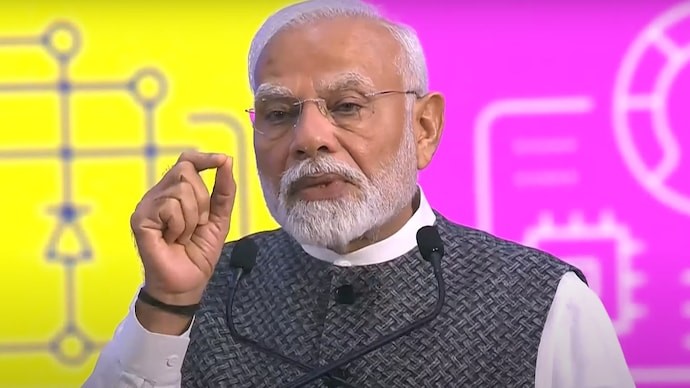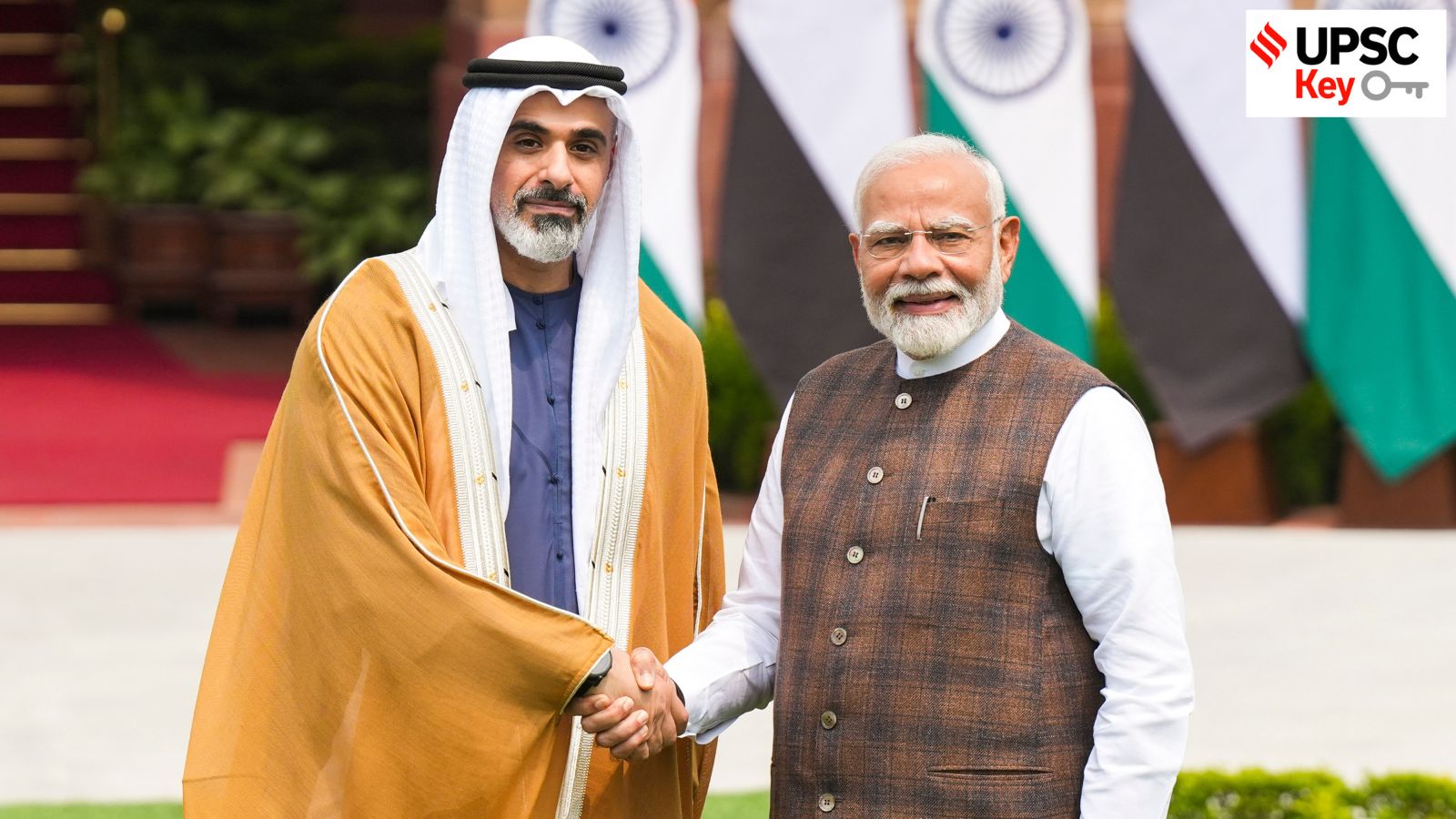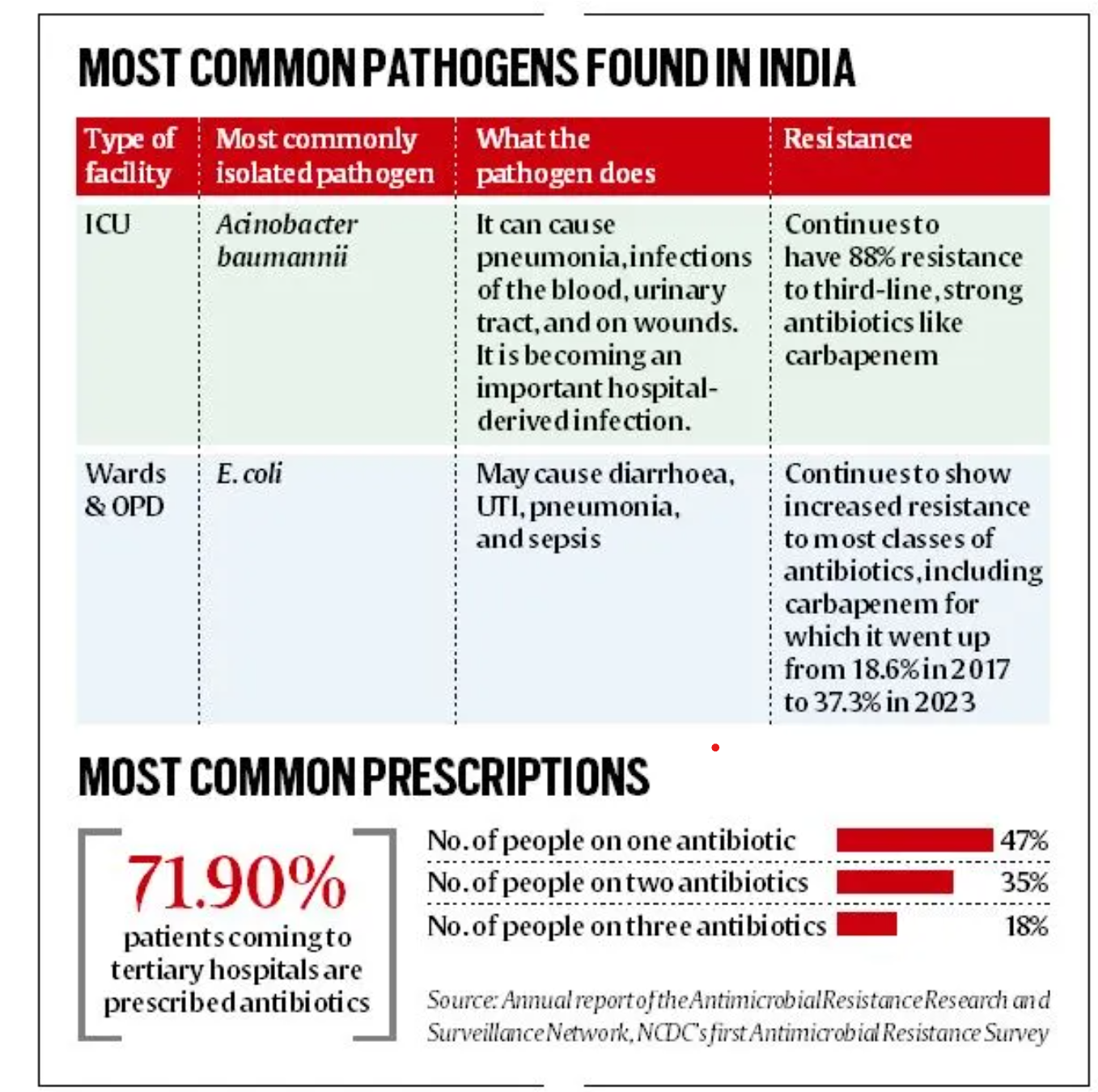SEMICON 2024

- 11 Sep 2024
In News:
Recently, Prime Minister Narendra Modi addressed the SEMICON 2024 conference on the outskirts of the national capital, advocating for increased investment in semiconductor manufacturing and resilient supply chains.
- Significance of Supply Chains: Emphasized the critical need for resilient supply chains, citing the COVID-19 pandemic as a stark reminder of their importance. The pandemic highlighted vulnerabilities in global supply chains, particularly affecting sectors dependent on chip imports from China.
- Investment in Semiconductors: Modi pitched India as a prime destination for semiconductor investments. He stressed that India aims to have an Indian-made chip in every global device and is committed to becoming a semiconductor powerhouse.
- India's Semiconductor Strategy:
- Reformist Government: Modi highlighted India’s reformist policies and stable business environment as key attractions for semiconductor investments.
- Growing Manufacturing Base: Expanding manufacturing infrastructure in India as a critical factor.
- Aspirational Market: The evolving technology market in India is seen as a strong incentive for semiconductor production.
- Government Commitment: Modi announced that over ?1.5 lakh crore has already been committed to semiconductor manufacturing, with several projects currently in the pipeline.
- Semicon India 2024 Focus:
- Event Goals: SEMICON India 2024 is a three-day conference designed to showcase India’s semiconductor strategies and policies, aiming to position the country as a global hub for semiconductor manufacturing.
- Workforce Development: The government is developing a semiconductor workforce of 85,000 engineers, technicians, and R&D experts.
- Market Growth: India’s semiconductor market, valued at $23.2 billion, is projected to reach $80.3 billion by 2028, with a compound annual growth rate (CAGR) of 17.10%.
- Importance of Semiconductors: Semiconductor chips as crucial for fulfilling the aspirations of millions and noted their role in India’s Digital Public Infrastructure (DPI), which remained effective during the pandemic when other countries’ banking systems struggled.
- Event Participation: SEMICON India 2024 will feature over 250 exhibitors and 150 speakers, including top executives from global semiconductor companies, industry leaders, businesses, and experts from around the world.
PresVu

- 11 Sep 2024
According to the company, the eye drop PresVu is the first of its kind in India, and that Entod has “applied for a patent for this invention in terms of its formulation and the process”.
Mumbai-based Entod Pharmaceuticals has announced that the Drug Controller General of India (DCGI) — the country’s apex drug regulator — has approved its new eye drop, which has been “specifically developed to reduce dependency on reading glasses for individuals affected by presbyopia.”
According to the company, the eye drop PresVu is the first of its kind in India, and that Entod has “applied for a patent for this invention in terms of its formulation and the process”.
What is presbyopia?
Presbyopia is an age-related condition in which the eyes gradually lose the ability to focus on nearby objects. People usually start to develop presbyopia at around the age of 40. According to doctors, spectacles are one of the most effective ways to manage the condition.
How does PresVu work?
- The active ingredient — chemical compounds in medicines that have an effect on the body — in PresVu is pilocarpine. The compound contracts the iris muscles, which control the size of the pupil and help humans see things clearly, thereby enabling one’s eyes to focus better on nearby objects, according to Entod Pharmaceuticals.
- The company also said that PresVu uses “advanced dynamic buffer technology” — essentially, a base solution — to adapt to the pH level (a scale used to measure how acidic or basic a substance is) of tears. This ensures that the eye drop has “consistent efficacy and safety for extended use, keeping in mind that such drops will be used for years at a stretch”.
- PresVu is a prescription-only medicine and, according to doctors, its impact is unlikely to last beyond four to six hours. It should not be used by people who have inflammation of the iris. Regular use of PresVu may lead to itching and redness, eyebrow pain, and muscle spasms in the eyes.
Is this a novel therapy?
- Although Entod’s claims make it seem that PresVu is a new therapy, pilocarpine, the main compound used in the eye drop, has been available in India for decades now.
- The United States Food and Drug Administration approved a pilocarpine eye drop for presbyopia in 2021.
- In India, the government decides on the ceiling price of pilocarpine in 4% and 2% concentrations. PresVu has pilocarpine in 1.25% concentration.
Strengthening India-UAE Relations

- 11 Sep 2024
The bilateral relationship between India and the UAE has flourished in recent years, marked by deepening strategic ties and multifaceted collaboration. The recent visit of Abu Dhabi's Crown Prince to India highlights the growing importance of this partnership. The UAE is now India's second-largest export destination, third-largest trading partner, and fourth-largest investor. The Comprehensive Economic Partnership Agreement (CEPA), effective from May 2022, has been transformative, boosting total trade by nearly 15% and increasing non-oil trade by 20% in the 2023-24 period.
Significance of the UAE for India
- Economic Gateway: The UAE is a crucial entry point for India into the Middle East and North Africa (MENA) region. As India's third-largest trading partner, bilateral trade reached USD 84.5 billion in FY 2022-23. The CEPA, removing tariffs on 80% of Indian exports to the UAE, has led to a 5.8% increase in non-oil trade early in 2023 and is expected to elevate trade to USD 100 billion by 2030. The UAE’s strategic location and infrastructure make it an ideal hub for re-exporting Indian goods to Africa and Europe.
- Energy Security: The UAE is India's fourth-largest crude oil supplier, with oil imports surging by 81% in January 2024. The partnership extends to renewable energy projects, aligning with India's goal of 500 GW renewable energy capacity by 2030, underscoring the UAE's role in India's energy transition.
- Investment Catalyst: FDI from the UAE to India has increased more than threefold, reaching USD 3.35 billion from USD 1.03 billion in 2021-22. The UAE-India High-Level Joint Task Force on Investments has played a key role, with significant investments like the Abu Dhabi Investment Authority’s Rs 4,966.80 crore in Reliance Retail Ventures Limited.
- Strategic Partner: The UAE has become a vital strategic ally for India in counterterrorism and maritime security. The bilateral naval exercise "Zayed Talwar" in 2021 and India's access to the UAE’s Al Dhafra air base highlight the expanding defense cooperation between the two nations.
- Remittances and Soft Power: The 3.5 million-strong Indian diaspora in the UAE is a major source of remittances and cultural influence. In 2022, India received nearly USD 111 billion in global remittances, with the UAE as a significant contributor. The diaspora also strengthens cultural ties, as evidenced by the BAPS Hindu Temple in Abu Dhabi, symbolizing the UAE’s commitment to religious tolerance.
- Tech and Innovation Hub: The UAE-India partnership is increasingly focused on technology and innovation. The I2U2 group (India, Israel, UAE, USA) aims to enhance cooperation in clean energy and food security. The UAE’s USD 2 billion investment in food parks in India and the UAE-India Artificial Intelligence Bridge, launched in 2018, facilitate joint research and position both countries at the forefront of technological advancement.
Areas of Friction
- Labor Rights: Persistent labor rights issues for Indian workers in the UAE, including passport confiscation and wage theft, remain a concern.
- Geopolitical Tensions: India’s growing ties with Israel and the UAE’s normalization with Israel complicate the geopolitical landscape, potentially entangling India in regional rivalries, especially with Iran. The UAE’s increasing ties with China also add strategic complexity.
- Energy Transition: Both nations’ commitments to net-zero targets—India by 2070 and the UAE by 2050—pose challenges to their traditional hydrocarbon-based relationship.
- Trade Imbalance: Despite growing trade, India’s trade deficit with the UAE stood at USD 16.78 billion in FY 2022-23. While the CEPA aims to address this, diversifying trade beyond hydrocarbons remains a challenge.
- Maritime Security: Coordinating responses to maritime security threats while respecting strategic autonomy is challenging. The UAE’s expanding naval presence and India’s growing maritime footprint require careful coordination.
Enhancing Relations
- Digital Diplomacy: India could use its IT capabilities to develop digital platforms for collaboration, including a real-time trade portal and a joint innovation hub, and expand cross-border digital payments.
- Green Energy Corridor: Proposing an "India-UAE Green Energy Corridor" could align with both nations’ climate goals through joint investments and research in renewable energy.
- Skill Bridge Program: A "Skill Bridge Program" could upskill Indian workers for the UAE job market, focusing on emerging sectors like AI and sustainable technologies.
- StartUp Synergy Scheme: Developing a "StartUp Synergy Scheme" could foster collaboration between Indian and UAE startups through joint incubation programs and market access facilitation.
- Maritime Cooperation Blueprint: Creating a comprehensive "India-UAE Maritime Cooperation Blueprint" could enhance collaboration in maritime security, blue economy initiatives, and port development, including joint patrols and deep-sea ports.
Polaris Dawn Mission: First Private Spacewalk Attempt

- 11 Sep 2024
Recently, a SpaceX Falcon 9 rocket launched from Florida, carrying American billionaire Jared Isaacman and three other astronauts into orbit for the Polaris Dawn mission. This five-day mission marks a milestone as it aims to achieve the world’s first private spacewalk. Polaris Dawn is the inaugural flight of the Polaris Program, a collaborative effort between Isaacman and SpaceX, led by Elon Musk. The program's goal is to develop innovative technologies for future Mars missions.
What is a Spacewalk?
A spacewalk, or “extravehicular activity” (EVA), involves an astronaut conducting activities outside a spacecraft while in space. The concept of a spacewalk dates back to March 18, 1965, when Soviet cosmonaut Alexei Leonov performed the first EVA during the Space Race. Leonov's spacewalk lasted just 10 minutes.
Modern spacewalks typically occur outside the International Space Station (ISS) and can last between five and eight hours. Astronauts conduct spacewalks for various purposes, such as performing scientific experiments, testing new equipment, or repairing satellites and spacecraft.
During a spacewalk, astronauts wear specially designed spacesuits and use safety tethers to prevent floating away into space. These tethers have one end attached to the astronaut and the other secured to the spacecraft. An alternative safety device is the SAFER (Simplified Aid for EVA Rescue), a backpack with small jet thrusters controlled by a joystick, which helps astronauts maneuver in space.
Objectives of the Polaris Dawn Mission
The Polaris Dawn mission, utilizing SpaceX’s Dragon capsule, aims to reach an altitude of approximately 1,400 km from Earth. This altitude exceeds the previous record set by NASA’s Gemini XI mission in 1966, which reached 1,372 km. At this height, the mission will be deep within the Van Allen radiation belts, which start around 1,000 km altitude and are known for their high levels of radiation. The crew will study the effects of spaceflight and radiation on human health.
Following this high-altitude phase, the Dragon capsule will descend to a lower orbit to facilitate the spacewalk scheduled for the third day of the mission, Thursday. During the spacewalk, the capsule will be depressurized, and the hatch will open, exposing the interior to the vacuum of space. Only two crew members, Isaacman and Gillis, will exit the capsule, while Poteet and Menon will remain inside to manage safety tethers and monitor the mission’s status.
The primary objective of the spacewalk is to test SpaceX’s newly developed EVA spacesuits. These suits, designed specifically for this mission, feature built-in cameras and heads-up displays to provide real-time information about the suit's condition. They also incorporate advanced thermal management systems.
After the spacewalk, Isaacman and Gillis will return to the capsule, which will then be repressurized before resuming its mission activities.
Additional Mission Activities
Throughout the mission, the crew will conduct 40 scientific experiments. These include attempting to capture X-ray images using natural space radiation instead of traditional X-ray equipment. The mission will also test SpaceX’s Starlink satellite network for laser-based communication, allowing satellite-to-satellite communication without relying on ground-based infrastructure.
The grave threat from AMR

- 11 Sep 2024
Antimicrobial resistance (AMR) poses a significant threat globally, with escalating concerns in India. AMR arises when microbes evolve into drug-resistant ‘superbugs’ due to the misuse or overuse of antibiotics. This phenomenon is exacerbated by the September 26 UN General Assembly High-Level Meeting on antimicrobial resistance, which highlighted the World Health Organization’s (WHO) recent guidance on antibiotic pollution from manufacturing.
AMR and the emergence of "superbugs" have far-reaching implications for healthcare systems, particularly affecting patients with multiple health conditions. According to a survey by the Indian Council of Medical Research (ICMR), AMR is on the rise across India, underscoring the urgency of addressing this issue.
What is Antimicrobial Resistance (AMR)?
AMR occurs when pathogens gain the ability to survive and cause infections despite the presence of antimicrobial drugs. This resistance is a result of microbes evolving in response to inappropriate or excessive use of antibiotics. The proliferation of resistant strains can lead to the creation of 'superbugs' that are resistant to commonly prescribed antibiotics. These resistant pathogens can spread through hospitals, drinking water, and sewage systems, complicating the treatment of infections.
Why is AMR Increasing?
- Individual Practices: Many people in India take antibiotics without medical consultation, especially for viral infections like the flu, where antibiotics are ineffective. This misuse contributes to the development of resistance.
- Medical Practices: There is a need for improved education among doctors regarding the use of antibiotics. Broad-spectrum antibiotics, which target a wide range of infections, are more likely to induce resistance. A survey by the National Centre for Disease Control (NCDC) found that 71.9% of patients in hospitals were prescribed antibiotics, often not to treat existing infections but to prevent potential ones. This overprescription has diminished the efficacy of several antibiotics, such as Norfloxacin, and increased resistance to crucial antibiotics like carbapenems.
- Diagnostic Practices: Often, doctors prescribe antibiotics based on symptoms rather than diagnostic tests, leading to empirical treatments with broad-spectrum antibiotics. It is essential for doctors to use diagnostic tests to prescribe targeted antibiotics, minimizing unnecessary resistance development.
- Pharmaceutical Industry: The WHO’s recent guidelines on antibiotic pollution highlight the need for better management of wastewater and solid waste from antibiotic manufacturing facilities. Despite known high levels of antibiotic pollution, regulatory oversight remains limited.
Common Resistant Pathogens in India
In India, the most prevalent resistant pathogens include:
- E. coli: Responsible for gut infections, with susceptibility to carbapenems decreasing from 81.4% in 2017 to 62.7% in 2023.
- Klebsiella pneumoniae: Causes pneumonia and urinary tract infections, showing reduced susceptibility to carbapenems from 58.5% to 35.6% and 48% to 37.6% between 2017 and 2023.
- Acinetobacter baumannii: Primarily associated with hospital-acquired infections, with resistance to carbapenems at 88% in 2023.
Key Actions Required
- Prevention: Enhance infection prevention through better hygiene, sanitation, and vaccination.
- Education: Train doctors on the judicious use of antibiotics, reserving potent antibiotics for severe cases, and ensuring appropriate diagnostic testing.
- Regulation: Implement regulations to control antibiotic pollution from manufacturing processes and investigate resistance pathways.
